Years ago there was a nasty person in my life. She would call to harangue my husband and leave vitriolic messages for me. This was in the days before iPhones, when the telephone was mounted on the wall of the kitchen. I’d hear the ring, or pass by and see that little red light indicating that a message was waiting, and I’d get a pit in my stomach and tightness in my chest. That beige phone became the harbinger of bad things. Even if I knew that a friend was calling, the sound of that phone made me ill. Behavioral scientists call objects (or words) that are associated with bad events conditioned punishers. By definition, a punisher stops a behavior. I stopped answering the telephone. Places can become punishers as well. A child who has been bullied in a classroom will not want to step foot in the school building.
I finally managed to make that nasty person stop calling. If she couldn’t be civil, we didn’t engage. Angry people need anger to feed on. She faded away. But that phone remained. I didn’t realize how much it affected me until we moved. The phone in my new kitchen wasn’t a conditioned punisher. My heart didn’t seize up when it rang. After a few weeks my entire body relaxed. I hadn’t recognized the tension I carried until it was no longer there.
I tell you this because for many horses, the ring is the equivalent of my telephone, and like the telephone, no one realizes the effect until it’s gone.
Schooling your horse, day in and day out, in the same confined place is boring. It’s physically demanding. What you’re doing might cause discomfort, or worse. The horse lags. Whips and spurs are used to get forward movement.
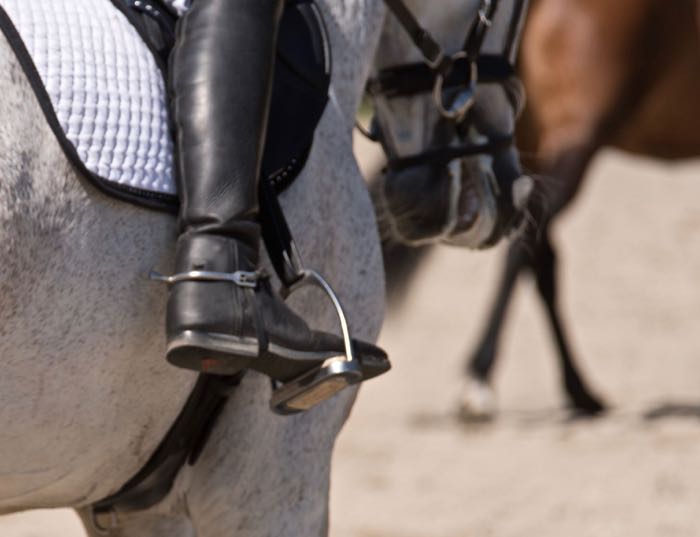
If this is what the horse associates with being in the ring, then not only will the bridle, whip and spurs cause pain, but the ring itself will trigger anxiety.
This doesn’t mean that you stop riding in a ring, or training, or challenging your horse, or developing them to be the athletic animals that they are designed to be. But, think about this: punishers decrease the likelihood of the occurrence of a behavior. We’ve been taught that whips and spurs are aids to move our horses on. (I’ve written more about whips here.) But if your horse requires ever-increasing pressure, if he lacks enthusiasm for the riding, then a punisher is at work. Perhaps the punisher has morphed beyond the physical things that you are doing. Perhaps it is the ring itself. Ask yourself, do you want to put your horse in an environment that he perceives of as bad so that you start your ride from a negative place?
The solution, of course, is not cut and dried. Conditioned punishers are hard to train away. You could begin by changing the way that you ride, so that you focus on rewards and not threats. But even if you toss out the spurs and crank noseband, no rider is perfect. As sensitive as I try to be, there are moments when Tonka resists doing what I ask; perhaps it is physically difficult, perhaps I’m off-balance myself. Athletic pursuits don’t come without pushing oneself. Sometimes what we do is not pretty. (In this photo he’s rushing, hollow through his back and bracing against my hands. My heels are up, tipping me forward, my forearms are tense and the joint in my elbow lacks elasticity. )
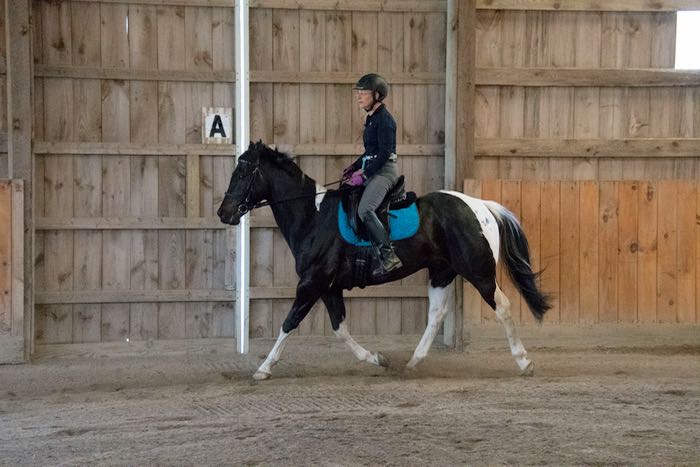
However, I am aware of these moments and do my best to keep them at a minimum. They’re moments within an overall picture that is based on small increments done right, that are rewarded generously.
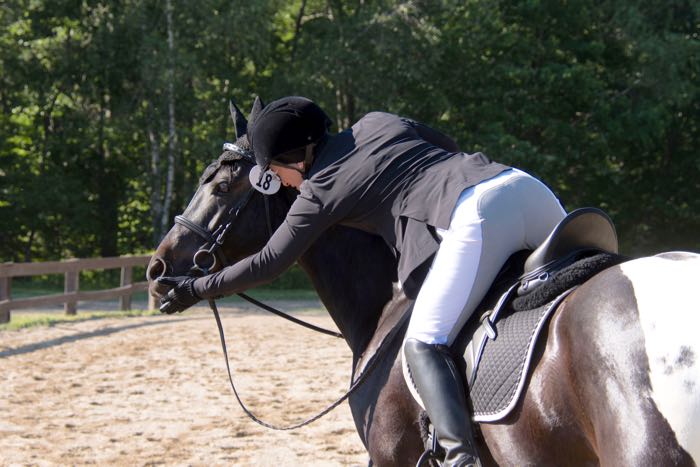
But even if I was a perfect rider, and Tonka and I were always 100% in sync, traveling only within the confines of a ring would become punishing to him. Horses are animals of the steppes. Their bodies need to move. If they don’t, their joints hurt, their legs swell, their bellies sag, and their muscles ache. They’re also curious, intelligent animals that need to look ahead and discover new vistas. No wonder the lesson horse that carts children around and around becomes duller and duller. No wonder the dressage horse loses her sparkle. There’s an answer to this. Get out. Go exploring as often as you school in the ring. Allow your horse to swing his head, look around and to pick his way over uneven ground.

Go alone. Go with a friend. Get out.
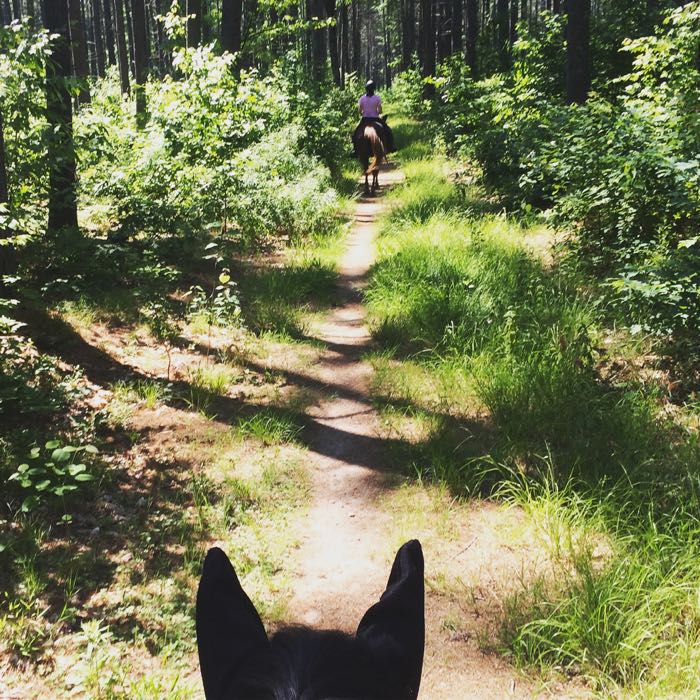
In the woods you’ll rediscover relaxation, forward, swinging strides and being companionable with your horse. Which is what it’s about, really.
Then, when you get back into the ring, it’s just one more place to do something interesting, together.
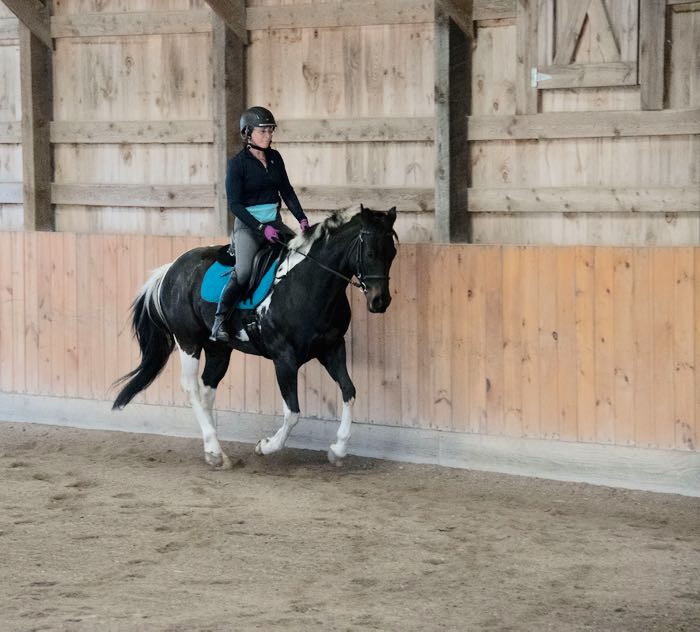


So pleased that nasty women went away and you have come through it. Bullying and punishing whether human or animal is unforgivable and I really feel for those who have to suffer. I agree that variety is always best in what ever you do whether work or play keeps your mind and body fresh.
Also I love the pic on FB of the horse eating the flowers very funny…:)
You’ve had a lot of variety in your life!
I really like the last picture of the person riding ahead of you. I’ve taken a lot of pictures like that, and I always try to get the horses ears in the picture like you did. I don’t show anymore, just trail ride, but I feel the horses still like some variety, like a new or different trail somewhere.
Variety is good. Even the same trail changes – with the season, with the weather, the birds we see.
Mental breaks. Experiencing joy with your horse. Engaging on a different, more fun and playful level with your horse. In addition to the kindness-based schooling you espouse, these are all topics that are dear to my heart. As I’ve mentioned before, I spent many years rehabbing or retraining ex-racers into calm, stable, pleasure horses. For many, due to the intense nature of their training, simply being saddled would cause them to begin sweating in anticipation of stress. So many had lived a life of episodes of intermittent panic, brusque handling and unnatural stimulus. In addition to taking their training allllll the way back to step one –simple halter, grooming and the most basic handling, tapping into their mental well being was key. For some, simply dropping them into a calm, gentle and very predictable routine helped enormously. For others, a change in diet and much longer opportunities to be at liberty, grazing in a small ‘herd’, were the answers. For the most anxious, and stimulus-needy, however, I did a lot of hand walking. Usually using elastic leads, and generously padded halters.
But without the doubt, if you want to see a happy horse….take them to a creek. I was fortunate to have a seasonal creek running through one end of my main pasture. It varied from about 8″ deep to 2-3 feet deep and had a wide turn that offered a natural “sand bar”. Even the most timid horses loved to stand securely on that sand bar, occasionally pawing the soft footing and taking long drinks and splashing around with their noses at the edge of the water. The more adventurous would plunge right in, wading around, pawing and eventually rolling in the cold, slowly moving water. Over and over. A few, like a 27 year old, retired dressage horse, still possessing the beautiful musculature of an athlete, but with the achy or stiff bones of an old man, would walk gingerly down the bank onto the sand bar, carefully arrange his feet in about a foot of water, slow fold down into the water and roll, roll, roll. Then, he’d pull his feet in, but still lying down, rest his muzzle on his bent front leg, close his eyes, and doze in the sun. I’d unhook his lead rope and leave him there, attending to other horses. He’d stay for hours in his own spa of moving water, cooling in the hot summer day, without a care in the world. Often Boo Boo, my ridiculously small pony, would lie down near him and the two would commune with nature together.
In my opinion, sometimes asking little, making no demands, and associating your presence with only good things in their minds, is the least we can do for enjoying years of ‘performance’.